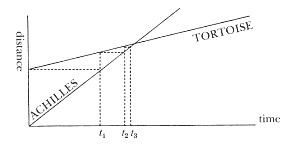Thanks to Harold Ship, I came across a post by Bill Lee entitled "Investing in 2013: It's about time not location". Lee claims that while there have been much traction around location based solutions, the location by itself has less value that the time of occurrence of past or future events. In the figure above, it might be more interesting WHEN Achilles is going to bypass the tortoise than where it is going to happen. Saying that a traffic congestion is going to occur at a certain location might be meaningless without prediction about the timing of the traffic congestion. It is more valuable to know when the delayed aircraft is going to land than just to know where it is now, it is more valuable to know when the technician is expected to arrive than just to know where he is now. I don't really care where the guy who delivers my pizza is now, but I definitely want to know when he is going to arrive. Lee claims that in the USA alone businesses lose $90 Billion annually due to people running late, whether it is the employee, or the technician for whom the employee waits at home. The claim is that time-based services is a good topic for 2013 investors to pursue, whether location is involved (spatiotemporal capabilities) or not. As the timing of these time-based services is associated with current or predicted events, event processing is a key for such services. I'll write more on time-based services later.
This is a blog describing some thoughts about issues related to event processing and thoughts related to my current role. It is written by Opher Etzion and reflects the author's own opinions
Saturday, January 12, 2013
Thursday, January 10, 2013
Recent paper about spatiotemporal event processing
Recently we see more work on spatiotemporal event processing. I came across a recent paper, authored by
Foued Barnouni and Bernard Moulin from Laval University which deals with spatiotemporal event patterns.
The generic form of a spatiotemporal pattern is shown in the figure below, first the temporal relation is evaluated and then the spatial relation, where the spatial patterns can be of three types: distance, topology and direction. The model also supports qualitative pattern such as "far", "near", "very near" enables the definition of fuzzy qualifiers in a pattern. The paper provides good overview of the spatiotemporal event processing topic, as well as a specific model implemented by a combination of TreeSap, a qualitative reasoning GIS system, and the event processing part is implemented in Esper.
From Australia - 2013: The Year of the Internet of Things
The complexevents site by David Luckham has undergone a face-lifting and has a nice new format.
In its current feature article it links to an article from CSIRO, Australia, entitled: "2013: The Year of the Internet of Things". Arkady Zaslavsky from CSIRO, who deals for years in context aware computing points out several successful IoT projects in Australia -- one of them is in agriculture, using sensors to check the best conditions for certain plants, other examples are public transportation track in big cities and monitoring sporting performance. The illustration above taken from this article compares 2010 and (predicted) 2015 quantities of Internet data in petabytes (petabyte = 1 million gigabytes) by industries, where in 2010 most data was created by humans, and the shift is that most data on the Internet will be created by sensors.
Subscribe to:
Comments (Atom)


